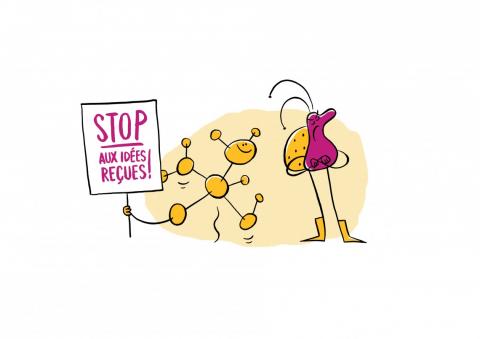NO to popular misconceptions in chemistry! (1/3)
At a time when climate, the environment and the protection of our planet are finally taking centre stage, Université Paris-Saclay...

At a time when climate, the environment and the protection of our planet are finally taking centre stage, Université Paris-Saclay, which has a large community of chemists with its researchers and students, has chosen to focus on chemistry. This exciting discipline, which studies the composition, properties and transformations of matter, suffers from a negative public image. The time has come to correct the stereotypes that overshadow the variety and wealth of the fields of chemistry, covered by research, training and professions. It is also time to shed light on the way chemistry contributes to major societal issues. "NO to popular misconceptions in chemistry!": a series of deliberately quirky illustrations that we hope will spark a debate! (Episode 2/3)
The activity of some drugs derived from natural extracts is remarkably useful in treating illnesses. Paclitaxel, or Taxol, for instance, is extracted from yews, fairly common ornamental trees. Its cytotoxic properties, meaning it is toxic to a certain type of cell, are used in cancer chemotherapy, particularly for ovarian, breast and lung cancer. It is included in the World Health Organization’s (WHO) model list of essential medicines for such conditions. As yews’ production output of Taxol is relatively low, chemists’ knowledge and synthesis of paclitaxel in laboratories makes it possible to cut down less yews and treat a considerable amount of people. Another active ingredient, docetaxel, synthesised from a natural substance extracted from yew needles, has an anti‑cancer activity nearly double that of paclitaxel.
Today, thanks to the collective awareness of the plastic industry and governments, and due to the technical and technological progress made in chemistry, many plastics - which are oil derivatives - are recycled or recovered, mainly by chemical processes. New production methods based on the founding principles of green chemistry are also emerging. They recommend the use of catalysts or take into account the degradation of the product to limit the impact on the environment as much as possible. Biosourced alternatives are also booming. They consist in using natural, renewable and biodegradable resources to produce products for everyday use, the majority of which are used in the plastic waste generated.
As everything that is made of atoms is chemical, it is only to be expected that cosmetics, made of different active ingredients, excipients and additives (dyes, foaming agents, etc.) are “full of chemical substances”. Moreover, most of the compounds used in cosmetics are of natural origin and hardly transformed at all, such as the fragrances in perfumes, most frequently extracted from plants and flowers, and the fats and oils in soap.
(Drawings by Elena Vieillard)
At a time when climate, the environment and the protection of our planet are finally taking centre stage, Université Paris-Saclay...
At a time when climate, the environment and the protection of our planet are finally taking centre stage, Université Paris-Saclay...